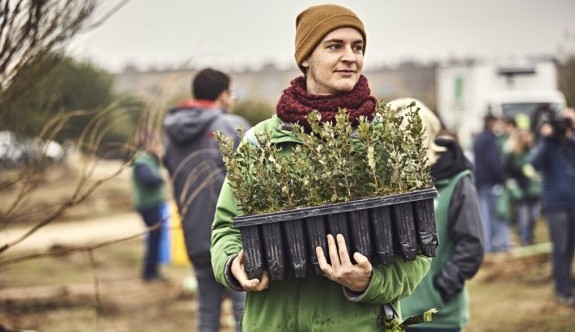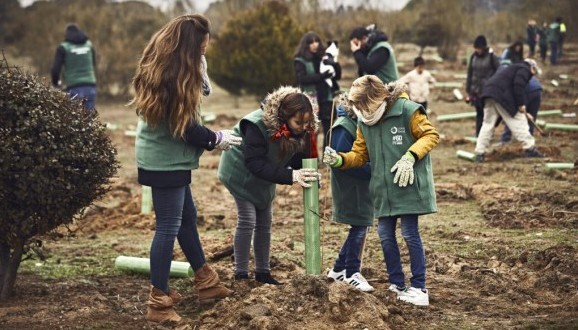Life Terra: apply the scientific criteria to plant a tree for every inhabitant of Europe until 2025
CREAF is taking part on an international project to plant a tree for every inhabitant of Europe following scientific methodologies and knowledge. The goal: to mitigate the effects of climate change and improve the planet's environmental health.
Planting 500 million trees in Europe by 2025 using scientific criteria and promoting environmental education among citizens is the main objective of Life Terra, an international project in which CREAF participates with a team of researchers from the University of Barcelona. The aim of this initiative is to mitigate the effects of climate change with the participation of the whole of society.
The initiative aims to involve nearly 50 million volunteers in planting trees and to raise awareness among up to 100 million people through activities and awareness-raising campaigns to protect the environment. The project, which aims to promote sustainability and the green economy throughout Europe, is promoted by Sven Kallen, founder of the Life Terra Foundation, and involves the participation of UB experts from CREAF Santi Sabaté and Francesc Sabater, as well as Teresa Saura, all three from the Department of Evolutionary Biology, Ecology and Environmental Sciences of the Faculty of Biology of the Univeristy of Barcelona.
Plantations with scientific criteria
The UB-CREAF team, which actively collaborates in these conferences, participates in the review and scientific advice on the criteria and the realization of the plantations. It is a task that involves knowing and analyzing the characteristics of the natural habitat and the most resilient species in the environment - for example, using regrowth species in case of areas susceptible to fires - to achieve a more effective forest restoration. The team also oversees the prior preparation of plant material from nurseries and possible combinations of species for different environmental conditions, as well as promoting the transfer of knowledge (elaboration of scientific material, dossiers and protocols, teaching material for primary and secondary schools) for all members and entities collaborating in the project.
"We must not forget the importance of involving the whole of society through the transfer of knowledge. It is important for citizens to do things because they understand the challenges, not because we tell them about them", remark Santi Sabaté, Teresa Sauras and Francesc Sabater. "We are also interested in scientifically monitoring the action and evaluating what has worked, what has not, and how what can be improved can be corrected. That is, to incorporate information and indicators that help us better decide on strategies for reforestation.

Each tree in its best natural habitat
"Climate change and all the consequences it entails is one of the main threats to the conservation of forest ecosystems around the world," says Professor Santi Sabaté, principal investigator of the project at the UB and a member of CREAF. On the one hand, due to the change in environmental conditions it generates (increase in temperature, changes in rainfall, etc.), and on the other, due to the disturbances related to these changes, which increase (fires, droughts, storms), pest expansion, etc)."
Each hectare of restored forest can capture about 200 tons of carbon dioxide over a period of forty years. With this premise, Life Terra has promoted the planting of thousands of trees and shrubs in different parts of the country and throughout the European continent. Each planted tree is georeferenced and long-term monitored through an application created by Life Terra to monitor the growth and evolution of each specimen.

The days to plant trees and shrubs are open to the participation of all citizens most involved in the protection of the environment. In Catalonia, the natural spaces of the Bruc and the Llobregat Delta have been the scene of forest restoration days with the participation of volunteers and experts highly motivated by the call of Life Terra.
Each hectare of restored forest can capture about 200 tons of carbon dioxide over a period of forty years.
Restore nature with more involved citizens
In addition to involving and connecting citizens in nature conservation, Life Terra also seeks to inspire future generations to act on the challenges of climate change through an interactive online environmental education program. Life Terra will promote actions such as the possibility of being able to "adopt" a tree or participate in other individual or collective initiatives to offset carbon emissions and restore the planet's environmental health.
The Life Terra action combines efforts with European strategy and forestry policies to conserve biodiversity, the United Nations Sustainable Development Goals (SDGs) and the new growth strategy of the European Green Deal.
The climate project, which aims to contribute to the capture and storage of carbon through tree plantations, is co-financed with 7 million euros by the European Union’s LIFE program, which supports environmental projects. Life Terra has the participation in Spain of Volterra Ecosystems, Land Life Company, the University of Barcelona, Viveros Fuenteamarga and the Efe Agency, which participates in the consortium’s communication group through the Efeverde environmental information platform. Stichting, Gynzy, BrightVibes and Land Life Company (Netherlands) also collaborate internationally; CybELE and Natura i Home Foundation (Portugal); EURACTIV and European Schoolnet (Belgium); Communication Europe (Germany); Legambiente (Italy); IFER (Czech Republic) and CERTH (Greece).






